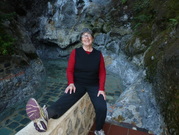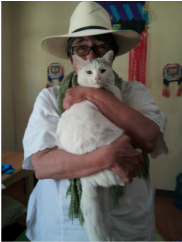Follow this link to read it with my photos at Que Pasa magazine http://www.quepasa.gt/born-in-heaven-uaxactun/_ or read it right here.
But harvesting chicle was a treacherous and poorly paid task. Solitary chicleros spent months navigating Petén’s jungle, confronting poisonous snakes, insects and aggressive animals, climbing and cutting the sapodilla tree and risking falls, fatal wounds, disease and dangerous missteps. They were paid by the weight of their collected chicle and had a reputation for wild partying when they finally hit camp at Uaxactún.
The chicleros were invaluable to the early archeologists who began exploring Uaxactún in 1916, helping them locate ruins hidden beneath the ferocious cover of plant growth and guiding them through the perils of the jungle. Based on discoveries from these early explorations, the Carnegie Institute funded the first extensive excavation of a Mayan site in Petén at Uaxactún between 1931 and 1938.
One of their most significant discoveries, known as Group E, is a Mayan observatory, still believed to be among the oldest in the Mayan world. The observatory, known as the Temple of Masks, faces three smaller temples that exactly frame the first light of the sun on the annual equinoxes and solstices. Over the course of a year, the angles of light form a triangle, the apex of which illuminates the same singular point on the Temple of Masks.*
On the spring equinox, Mayan shamans from around Guatemala perform traditional ceremonies at the ancient observatory. Visitors are welcome to attend, and many come in hopes of the sun defeating the jungle mist to rise over Temple IV. In past years, the spring equinox celebration at Uaxactún has included a dramatization of ancient Maya royalty, regional folkloric dance, a demonstration of the Mayan ballgame in the ancient ball court, a demonstration of chicle collection and a tour of Uaxactún’s sustainable xate, allspice, and hardwood industries.
The Carnegie excavation itself proved to be a landmark in Mayan archeology. A method for identifying and grouping ancient Mayan structures – still used today – was developed there. Uaxactún is believed to have experienced one of the longest continuous periods of habitation of any ancient Mayan city and boosts the earliest evidence of the use of the zero among the Maya. Much was learned about the Pre-classic and Classic Maya owing to the detailed reports of the archeological team. The early Carnegie excavation at Uaxactún also defined the developmental succession of Mayan ceramics, which remains the basis for identifying Pre-classic and Classic Mayan pottery.
A collection of over 500 pieces of this pottery is exhibited in an enchanting private museum at Campamento El Chiclero. Admittance to this intimate collection of Pre-classic and Classic ceramics is free. The unique pieces in this collection contain fine examples of the delicate art of the early Maya, many still bearing the original paint that once colored the ancient Mayan world. Created and maintained by Uaxactún resident Nería Herrera, the museum houses some pieces which were acquired by convincing early artifact thieves to part with these pieces in exchange for beer. While visiting the collection, it is possible to sense the daily lives of the Maya without a wall of glass separating the visitor from these ancient pieces.
The grassy strip of the former airfield, which bisects the village, now hosts afternoon soccer games, grazing horses and wandering chickens. The major ruin complexes are only a short uphill walk on either side of town and are well signed.
I found myself returning and staying for several days at a time in the basic but comfortable Campamento El Chiclero, drawn by the sense of antiquity, the unparalleled freedom to wander among the ruins, and the opportunity to explore this subsistence village where many of the homes are still built from local stones and thatch. On clear nights, the lack of electricity in Uaxactún allows a clear vista of the stars that the Maya tracked. In the early mornings, an easy climb to the top of the Temple of Masks provides a peaceful location for meditating on the enduring knowledge of the Maya while birds call out from nearby treetops and horses seem to materialize from the mist below. The palace complexes A, B & C offer hours of discovery and also display some of the more recent archeological discoveries. Indeed, some Mayan shaman and archeologists claim that this site, known as Sian K’aan, or “Born in Heaven,” was an important intellectual center for the ancient Maya.
Today the community of Uaxactún is a leader in the successful conservation of the Mayan biosphere. Because of this, the ruins are situated in a beautiful forest of arching hardwood trees, boasting a welcome breeze and fewer mosquitoes than Tikal – making it a touch of heaven indeed for travelers seeking a deeper connection with the ancient Maya.
• The local bus to Uaxactún leaves from Santa Elena daily at 2 PM and from Uaxactún daily at 6 AM. Trip time: 2½ hours.
• Private vehicles must register at the Tikal administration center.
• Admission: Q50, paid at Tikal National Park.
• Spanish-speaking guides are available for hire at Campamento El Chiclero. English-speaking guides need to be hired from Flores or El Remate.
Written and photos by: Louise Wisechild, Ph.D.
Louise Wisechild, Ph.D., is a writer and community-based tourism facilitator who blogs about Guatemala at www.brightfutureglobaltours.com/blog.html.
Tags: adventure in guatemala, discover destinations in guatemala, louise wisechild, mayan ruins in guatemala, mayan world, sightseeing in guatemala, tikal guatemala

 RSS Feed
RSS Feed

